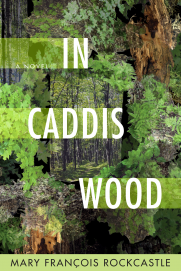In Caddis Wood Mary François Rockcastle (2011)
With prose that is reminiscent of the writing of Barbara Kingsolver, Mary Rockcastle takes her readers into the forests and meadows of the upper Midwest for a plaintive story of a long marriage.
Carl Fens is an architect who’s put in long hours away from his family as he’s built a stellar career. Hallie Bok has raised their twin daughters while trying to keep her hand in with writing poetry and teaching. The couple have suffered more than their share of sorrows, the details of which are revealed over the course of the novel: the early and sudden death of Carl’s father, the departure of Hallie’s mother when Hallie is young, a near-fatal accident involving one of their daughters, the death of a son-in-law. In flashbacks from old diaries, we learn that the previous owners of the family’s bucolic retreat lost a son in the Korean War. Readers need to keep track of all these side issues as the main plot unfolds.
In this main plot, Carl, at age 61, starts exhibiting unusual and troubling neurological symptoms. As part of Hallie’s search for a diagnosis, she inadvertently brings to light a near-affair that she had ten years previously, when she and Carl were briefly estranged. Carl and Hallie have to come to terms with this revelation at the same time that they’re dealing with Carl’s deteriorating health and his major new architectural commission involving redevelopment of a toxic waste site.
The backdrop for most of the novel is the Caddis Wood of the title, a magical place in northern Wisconsin, the site of the family’s second home. Here are just two examples of Rockcastle’s lyrical descriptions:
“[Hallie] rests her eyes on the late-summer glow of the meadow. The midday grasses are on fire: crimson bluestem, golden switchgrass, straw-colored sideoats grama. Blazing among the bronzed, stiff clusters of goldenrod and yarrow are hearty sunflowers and dogtooth daisies, coneflowers still in color. She sighs happily and drinks from her water bottle, loving the persistence of summer, the way it hangs on in the fading, somnolent heat.” (45)
“At the top of the hill overlooking Echo Pond, she gazes gratefully at the incandescent surface. Another week and the feathery larches will start to yellow, but not yet. Trees cast their shadows on the stippled surface. Water striders and whirligig beetles zigzag merrily.” (214)
A few scenes take place on Captiva Island in Florida, and this oceanside setting is also depicted lovingly: “Dozens of pelicans, more than Hallie has ever seen, are diving headfirst into the sea. When they surface, their beaks shimmer with silver, wiggling meat that is swallowed whole or spilled into the sea. Gluttonous gulls fight over the leftovers. A group of scarlet ibises land next to a crane, red legs aglow in the sunlight, and poke their long saffron beaks doggedly into the sand. The water shivers and pops as if charged with electric current.” (126)
After many heartbreaking life events, the family members in this novel still manage to treasure their time together and pursue their goals. The daughters of Hallie and Carl are named Cordelia (as in Shakespeare’s tragedy King Lear) and Beatrice (Dante’s guide through heaven in his Divine Comedy). Perhaps these names are meant to point out that, despite tragic experiences, we can all find our way to happiness.


